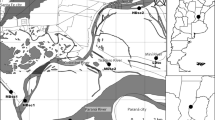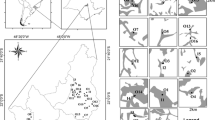Abstract
Woody debris is an important habitat component, particularly in streams that lack other hard substrates. Research suggests a general relationship between increasing invertebrate density, diversity, and taxa richness with increasing wood decay in lotic systems, with some authors observing invertebrate taxonomic succession as decay proceeds. We designed a field experiment using colonization of known-aged woody debris in two streams to examine patterns in invertebrate colonization, density, diversity, richness, and succession. After aging woody debris 0–6 weeks in laboratory tanks and then placing the debris in the two subtropical, coastal plain streams for five additional weeks, we did not detect any statistical relationship between invertebrate density, diversity, evenness, richness, or life-history pattern with increasing woody debris decay, nor did we detect any relationships between the colonization or abundance of individual taxa and the decompositional state of the wood. In this paper, we propose two non-exclusive explanations for these trends based on opportunistic colonization and evolutionary filtering. Despite the apparent unimportance of decompositional state, woody debris still supported many taxa and remains an important habitat component. Our research further supports the importance of flooding and maintenance of intact riparian and floodplain forests to the woody debris dynamics and macroinvertebrates in coastal plain lotic systems.
Similar content being viewed by others
References
Adams S. B. and Haag W. R. (2004). Spatial and temporal patterns in fish assemblages of upper coastal plain streams, Mississippi, USA. Hydrobiologia 528: 45–61
(2001). Standard Method of Evaluating Wood Preservatives by Field Tests with Stakes. Standard E7-01. American Wood-Preservers Association, Selma, AL, USA
Anderson N. H., Sedell J. R., Roberts L. M. and Triska F. J. (1978). The role of aquatic invertebrates in processing of wood debris in coniferous forest streams. American Midland Naturalist 100: 64–82
Barr C. B. and Chapin J. B. (1981). The aquatic Dryopoidea of Louisiana (Coleoptera: Psephenidae, Dryopidae, Elmidae). Tulane Studies in Zoology and Botany 26: 91–164
Benke A. C. and Wallace J. B. (2003). Influence of wood on invertebrate communities in streams and rivers. In: Gregory, S., Boyer, K. and Gurnell, A. (eds) The Ecology and Management of Wood in World Rivers. American Fisheries Society Symposium 37, pp 149–177. American Fisheries Society, Bethesda, MD
Benke A. C. and Wallace J. B. (1990). Wood dynamics in coastal blackwater streams. Canadian Journal of Fisheries and Aquatic Sciences 47: 92–99
Bond N. R., Sabater S., Glaister A., Roberts S. and Vanderkruk K. (2006). Colonization of introduced timber by algae and invertebrates, and its potential role in aquatic restoration. Hydrobiologia 556: 303–316
Braccia A. and Batzer D. P. (2001). Invertebrates associated with woody debris in a southeastern U. S. forested floodplain wetland. Wetlands 21: 19–31
Brown A. V. and Matthews W. J. (1995). Stream ecosystems of the central United States. In: Cushing, C. E., Cummins, K. W. and Minshall, G. W. (eds) River and Stream Ecosystems. Ecosystems of the World 22, pp 89–116. Elsevier, The Netherlands
Burcher C. L. and Smock L. A. (2002). Habitat distribution, dietary composition and life history characteristics of odonate nymphs in a blackwater coastal plain stream. American Midland Naturalist 148: 75–89
Collier K. J. and Halliday J. N. (2000). Macroinvertebrate-wood associations during decay of plantation pine in New Zealand pumice-bed streams: stable habitat or trophic subsidy?. Journal of the North American Benthological Society 19: 94–111
Conner J. V. and Suttkus R. D. (1986). Zoogeography of freshwater fishes of the western Gulf Slope of North America. In: Hocutt, C. H. and Wiley, E. O. (eds) The Zoogeography of North American Freshwater Fishes, pp 413–456. John Wiley and Sons, New York, New York
Dowdy S., Wearden S. and Chilko D. (2004). Statistics for Research. John Wiley and Sons, Inc, New York, NY
Drury D. M. and Kelso W. E. (2000). Invertebrate colonization of woody debris in coastal plain streams. Hydrobiologia 434: 63–72
Dudley T. and Anderson N. H. (1982). A survey of invertebrates associated with wood debris in aquatic habitats. Melandria 39: 5–21
Epler J. H. (2001). Identification Manual for the larval Chironomidae (Diptera) of North and South Carolina. A Guide to the Taxonomy of the Midges of the Southeastern United States, Including Florida. North Carolina Department of Environment and Natural Resources and St. Johns River Water Management District, Raleigh, NC
France R. L. (1997). Macroinvertebrate colonization of woody debris in Canadian Shield lakes following riparian clearcutting. Conservation Biology 11: 513–521
Golladay S. W. and Webster J. R. (1988). Effects of clear-cut logging on wood breakdown in Appalachian mountain streams. American Midland Naturalist 199: 143–155
Ice G. and Sugden B. (2003). Summer dissolved oxygen concentrations in forested streams of northern Louisiana. Southern Journal of Applied Forestry 27: 92–99
Johnson L. B., Breneman D. H. and Richards C. (2003). Macroinvertebrate community structure and function associated with large wood in low gradient streams. River Research and Applications 19: 199–218
Johnson R. A. and Wichern D. W. (2002). Applied Multivariate Statistical Analysis. Prentice Hall, New York, NY
Johnson Z. B. and Kennedy J. H. (2003). Macroinvertebrate assemblages of submerged woody debris in the Elm Fork of the Trinity River, Texas. Journal of Freshwater Ecology 18: 187–197
Kaller, M. D. & W. E. Kelso, 2006. Association of macroinvertebrate assemblages with dissolved oxygen concentration and wood surface area in selected subtropical streams of the southeastern USA. Aquatic Ecology (in press)
Kaller, M. D., 2005. Macroinvertebrate community ecology of lowland, subtropical streams in Louisiana. Ph.D. Dissertation, Louisiana State University, Baton Rouge, LA. http://etd.lsu.edu/docs/available/etd-03302005-151536/unrestricted /Kaller_diss.pdf
Magoulick D. D. (1998). Effect of wood hardness, condition, texture and substrate type on community structure of stream invertebrates. American Midland Naturalist 139: 187–200
Mathooko J. M. and Otieno C. O. (2002). Does surface textural complexity of woody debris in lotic ecosystems influence their colonization by aquatic invertebrates. Hydrobiologia 489: 11–20
O’Connor N. A. (1991). The effects of habitat complexity on the macroinvertebrates colonizing wood substrates in a lowland stream. Oecologia 85: 504–512
Omernik J. M. (1995). Ecoregions: A Spatial Framework for Environmental Management. In: Davis, W. and Simon, T. (eds) Biological Assessment and Criteria: Tools for Water Resource Planning and Decision Making, pp 49–62. Lewis Publishers, Boca Raton, FL
Phillips E. C. (2003). Habitat preference of aquatic macroinvertebrates in an east Texas sandy stream. Journal of Freshwater Ecology 18: 1–11
Phillips E. C. (1995). Associations of aquatic Coleoptera with coarse woody debris in Ozark streams, Arkansas. The Coleopterists Bulletin 49: 119–126
Phillips E. C. and Kilambi R. V. (1994a). Utilization of coarse woody debris by Ephemeroptera in three Ozark streams of Arkansas. The Southwestern Naturalist 39: 58–62
Phillips E. C. and Kilambi R. V. (1994b). Use of coarse woody debris by Diptera in Ozark streams, Arkansas. Journal of the North American Benthological Society 13: 151–159
Rinella, D. J., 2002. Influence of coarse woody debris on macroinvertebrate assemblages in Alabama coastal plains streams. M.S. Thesis, Auburn University, Auburn, AL
Rinella D. J. and Feminella J. W. (2005). Comparison of benthic macroinvertebrates colonizing sand, wood and artificial substrates in a low-gradient stream. Journal of Freshwater Ecology 20: 209–220
Robinson E. G. and Beschta R. L. (1990). Characteristics of coarse woody debris for several coastal streams of southeastern Alaska, USA. Canadian Journal of Fisheries and Aquatic Sciences 47: 1684–1693
Roeding C. E. and Smock L. A. (1989). Ecology of macroinvertebrate shredders in a low-gradient sandy-bottomed stream. Journal of the North American Benthological Society 8: 149–161
Spänoff B. and Meyer E. I. (2004). Breakdown rates of wood in streams. Journal of the North American Benthological Society 23: 189–213
Williams L. R., Bonner T. H., Williams M. G., Leavy T. R. and Williams C. S. (2005). Interactive effects of environmental variability and military training on stream biota of three headwater drainages in western Louisiana. Transactions of the American Fisheries Society 134: 192–206
Wood D. L. and Sites R. W. (2002). Submerged rootmats: A mesohabitat harboring a distinct insect community in Ozark streams. Journal of Freshwater Ecology 17: 431–440
Author information
Authors and Affiliations
Corresponding author
Rights and permissions
About this article
Cite this article
Kaller, M.D., Kelso, W.E. Short-term decompositional state does not influence use of wood by macroinvertebrates in subtropical, coastal plain streams. Hydrobiologia 571, 157–167 (2006). https://doi.org/10.1007/s10750-006-0238-5
Received:
Revised:
Accepted:
Published:
Issue Date:
DOI: https://doi.org/10.1007/s10750-006-0238-5




